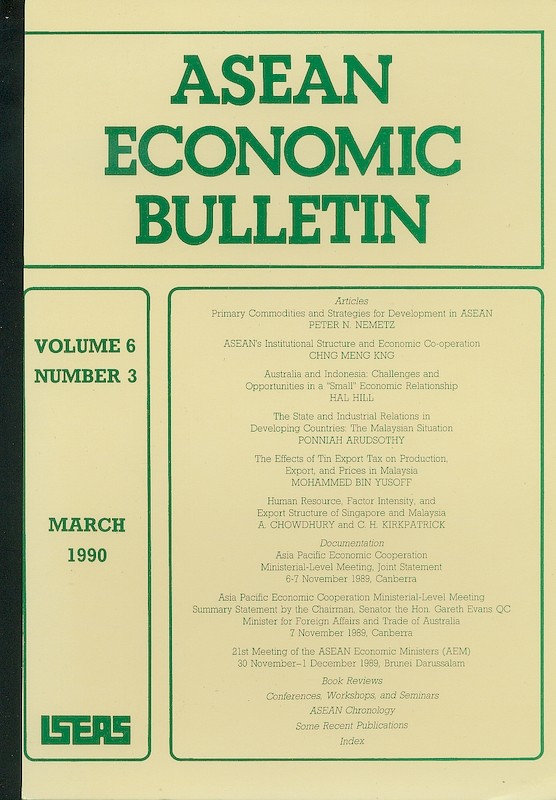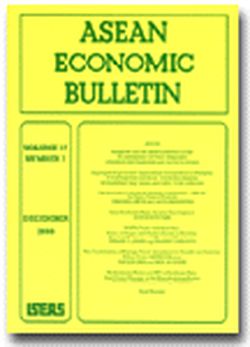ASEAN Economic Bulletin Vol. 9/3 (Mar 1993)

Date of publication:
March 1993
Number of pages:
132
Code:
AE9/3
Contents
-
Preliminary pages with Obituary: Professor Kernial S Sandhu, 1929-1992
- ARTICLES
-
A North American Free Trade Agreement and East Asian Developing Countries, by Han Soo Kim, Ann Weston, authors see abstractThis article analyses the implications of a North American Free Trade Agreement (NAFTA) between the United States, Mexico and Canada for China, Hong Kong, Indonesia, Korea, Malaysia, the Philippines, Singapore, Taiwan and Thailand. Those provisions most likely to discriminate against East Asian producers and investors, notably changes in tariffs, rules of origin, safeguards, dispute settlement, non-tariff barriers, and new rules for NAFTA investors are reviewed. Particular attention is given to textiles and clothing, autos and auto parts, steel, energy, services and the maquila industries. A quantitative assessment suggests that trade diversion will be small less than 0.5 per cent of exports to the United States. While both East Asian exposure in the North American market and the structural overlap with Mexican exports have been growing, neither suggests that any East Asian country will be seriously threatened by a NAFTA. The article concludes with a discussion of trade policy responses for East Asia.
-
Investment in Education in East Asia, by Jandhyala B G Tilak, author see abstractUsing the most recent data compiled from a variety of sources, this article presents a brief comparative educational profile of ASEAN member countries, other developing countries and developed countries of the East Asian region. Concentrating on financial conditions in education, the article analyses the investment in education, priority given to education in the national economies, intra-sectoral priorities, the unit costs, and the present mechanisms of funding education, including the role of the private sector in the same. The experience of East Asia may provide some important lessons for the developing countries in their endeavour to educate their people.
-
Financial Liberalization in Indonesia: Interest Rates, Money Market Instruments, and Bank Supervision, by Umar Juoro, author see abstractThe financial liberalization that Indonesia has undergone since 1983 has resulted in some successes, among others in financial deepening (M2/GDP), the availability of credit, more effective open market operation, and the growth of private bunking. It is suggested that financial liberalization may play an important role in attaining the high economic growth. By using the co-integration method, this article shows the significance of positive interest rates in increasing savings and credit availability. However, this study finds the problems of moral hazard and inadequate bank supervision have became serious obstacles for maintaining that success. Also using the co-integration method, this study shows that the narrower spread leads to higher deposit rates.
-
The Effects of Real Exchange Rate on the Demand for Exports: A Case of Malaysian Primary Commodities, by Mohammed Bin Yusoff, Ahmad Zubaidin Baharumshah, authors see abstractThis study examines the effect of the Malaysian dollar (ringgit) real exchange rate on the export demand for Malaysian primary commodities under alternative specifications and estimation procedures. The results suggest that the ordinary least squares estimates are inferior compared to the seemingly unrelated regression results. The price and exchange rate elasticities were found to be inelastic implying that the increase in the export demand due to ringgit depreciation may not be large enough to improve the balance of trade.
-
Incentives for Exports: The Case of Thailand, by Han Herderschee, author see abstractDuring the 1980s Thailand's economy grew very rapidly and between 1988 and 1990 GDP growth averaged 11.7 per cent, with the growth in exports of manufactured goods playing an important part in this growth. A large number of factors contributed to the rapid growth of exports from Thailand, but a number of government policies also created disadvantages ("distortions") for the competitiveness of Thailand's exports. This article examines the effects of the protective measures and the ways they were offset. It also looks at the changing relative importance of export incentives in Thailand since 1975. In the absence of import liberalization, protection offsets are becoming vital to the competitiveness of exports. A rise in the use of protection offsets involves increasing administration costs for both the exporting firms and the government. Removing import-substitution policies is a preferred alternative to "second-best" offsets to protection.
-
DOCUMENTATION: Press Releases on the CEPT Scheme
-
DOCUMENTATION: The New Era of the Asia-Pacific and Japan-ASEAN Cooperation Policy Speech by Prime Minister Miyazawa, Bangkok, 16 January 1993
-
DOCUMENTATION: The Asia-Pacific Area Needs a Stronger Sense of Community. Address by William Clark, Jr. to the Mid-America Committee, Chicago, 4 December 1992
-
BOOK REVIEW: The Pacific Economy: Growth and External Stability, edited by Mohamed Ariff, by Peter N Nemetz, author
-
BOOK REVIEW: "Trade Reform" Lessons from Eight Countries, edited by Geoffrey Shepherd and Carlos Geraldo Langoni, by Mangat Ram Aggarwal, author
-
BOOK REVIEW: The Impact of Trade-related Investment Measures on Trade and Development, by United Nations Centre on Transnational Corporations/United Nations Conference on Trade and Development, by Stephen F Wermert, author
-
Conferences, Workshops and Seminars
-
ASEAN Chronology 1992
-
Some Recent Publications
-
Index to Volume 9


